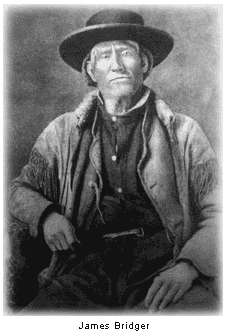James "Jim" Bridger was born on March 17, 1804, in Richmond, Virginia, the son of an innkeeper. In 1822, he headed west and quickly became an accomplished fur trapper. He would later become a partner in the Rocky Mountain Fur Company.
 During the 1820s and 1830s, Jim Bridger explored the West numerous times; during one venture, he became the first white man to see the Great Salt Lake.
In 1843, as the fur trade declined, Bridger became a partner in the establishment of Fort Bridger on Black’s Fork of the Green River in Wyoming, a prominent way station for travelers on the Oregon Trail. His knowledge of the territory was essential to the Central Overland Stage Company and the Pike’s Peak Express Company, both of whom hired him to aid in the establishment of their routes. Bridger later provided a similar service for the Union Pacific Railroad.
Jim Bridger was opposed to the Mormon settlements in the Utah area. Such settlements had sapped a considerable portion of Bridger's trade, including that of the Indians, causing economic hard times for the post and bad blood in the future. Eventually, Bridger volunteered to act as a guide for U.S. forces in the Mormon War of 1858.
In 1859-60, Bridger visited an area known as Colter’s Hell and later described its geysers and other natural features to unbelieving listeners. This region would later become Yellowstone Park.
Over his lifetime, Jim Bridger has three Indian wives. In the last years of his life, his health failed and after 1873 he gradually went blind. He died on July 17, 1881 near Kansas City, Missouri. Bridger National Forest, Bridger Pass, and the Bridger Mountains are some of the places named after him.
During the 1820s and 1830s, Jim Bridger explored the West numerous times; during one venture, he became the first white man to see the Great Salt Lake.
In 1843, as the fur trade declined, Bridger became a partner in the establishment of Fort Bridger on Black’s Fork of the Green River in Wyoming, a prominent way station for travelers on the Oregon Trail. His knowledge of the territory was essential to the Central Overland Stage Company and the Pike’s Peak Express Company, both of whom hired him to aid in the establishment of their routes. Bridger later provided a similar service for the Union Pacific Railroad.
Jim Bridger was opposed to the Mormon settlements in the Utah area. Such settlements had sapped a considerable portion of Bridger's trade, including that of the Indians, causing economic hard times for the post and bad blood in the future. Eventually, Bridger volunteered to act as a guide for U.S. forces in the Mormon War of 1858.
In 1859-60, Bridger visited an area known as Colter’s Hell and later described its geysers and other natural features to unbelieving listeners. This region would later become Yellowstone Park.
Over his lifetime, Jim Bridger has three Indian wives. In the last years of his life, his health failed and after 1873 he gradually went blind. He died on July 17, 1881 near Kansas City, Missouri. Bridger National Forest, Bridger Pass, and the Bridger Mountains are some of the places named after him.